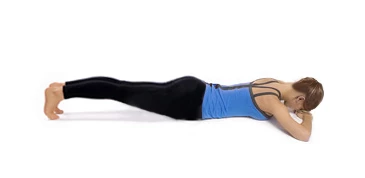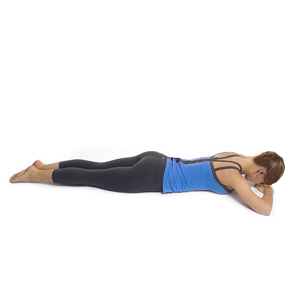A Simple Yoga Practice for Finding and Strengthening Your Pelvic Floor Muscles

Are your pelvic floor muscles developed? Early in life we learn to use most of the muscles in our body. Learning to walk, for example, involves the coordinated action of all the muscles of the legs and pelvis. Reaching for something or eating a meal requires skillful mastery of all the muscles of the arms and hands. We take this for granted, and never think twice about it. But compare the uncoordinated movements of a one-year old with the precise movements of an adult, and you will see just how extensive this learning process is.
There are some muscle groups that we may never learn to use, however. The core muscles are one case in point—unless you have an active yoga or exercise practice involving core engagement, you may never really develop a ‘feel’ for the core muscles, how to engage them, and how to use them for finer coordination of movement. As a result, many people go through life with a weak core, which becomes increasingly apparent with the age-related muscle weakening that accelerates after the age of 45.
Pelvic Floor Muscle Training
Another example of an important muscle group we rarely learn to consciously control is the pelvic floor muscles. Indeed, many people have little idea that they even have pelvic floor muscles, or, for that matter, what their function is. It doesn’t help that the pelvic floor muscles reside in a part of the body we are culturally conditioned to think of as taboo.
As a result, most of us are oblivious about the importance of this muscle group until we develop problems related to a weakened pelvic floor, such as reduced bladder or bowel control, prolapse, as well as reduced sexual sensation and orgasmic potential.
Like all muscles in the body, the pelvic floor muscles need to be used regularly to stay strong. Unfortunately, since most people have little idea about how to engage the pelvic floor muscles, they tend to get increasingly weak over time. The health of this muscle group is also affected by numerous other factors, such as pregnancy and childbirth, injury (such as a fall), ongoing constipation with constant straining to empty the bowels, excessive heavy lifting and core work (e.g. in the gym), as well as excessive weight.
Simple Yoga Exercises for Pelvic Floor Health
Strengthening the pelvic floor muscles can be tricky when you don’t even know how to engage them. So to develop a routine for pelvic floor health, the first step is to learn to engage, and relax, this elusive muscle group.
To help you find the pelvic floor muscles, try this simple yoga routine.

-
Lie down on your belly. Put your hands on top of each other and allow your forehead to rest on your folded hands, coming into a variation of Makarasana, Crocodile pose.
-
Flex your feet and curl your toes under. Bring your heels towards the back wall, so that the knees lift off the floor.
-
Lie here and pay attention to the movement of your breath and the bottom of your pelvis. In diaphragmatic breathing, the pelvic floor moves upward on the exhale in synchrony with the movement of the diaphragm. This prone position with the heels pulled back is particularly useful for feeling this subtle movement.
-
Each time you exhale, see if you can sense the movement of the pelvic floor upward, in tune with the breath. If you can’t, don’t worry, it often takes
 time to connect to this sensation. Just keep your awareness at the bottom of your pelvis as you breathe.
time to connect to this sensation. Just keep your awareness at the bottom of your pelvis as you breathe. -
Continue for 4-6 breaths, then relax your feet and legs, and turn your head. Rest for 3 to 4 breaths, just noticing the sensations in your body.
Stage 2. Pelvic Floor Strengthening
-
For the second stage of this routine, again, rest your forehead on your hands. Then curl your toes under and bring your heels towards the back wall so the knees come off the floor.
-
This time, as you exhale, imagine pulling the dome of the pelvic floor upward. As you inhale, release the pelvic floor muscles.
-
To feel the movement of the pelvic floor more distinctly, engage your leg muscles to move your heels backward with each exhale. Relax and soften with each inhale, but keep the feet curled under and the knees off the floor.
-
Continue for 4 to 6 breaths, then relax your legs, turn your head to one side, and move your hands by your side. Breathe and relax, completely letting go of the muscular engagement, and just notice the sensations in your body.
Once you master the art of contracting your pelvic floor muscles, try holding the lift for longer before relaxing, but be sure to let go and relax fully between contractions. Repeat up to 10 times, then rest for a minute or two, allowing yourself to feel the sensations in your body.
This is a powerful exercise, involving not just the physical part of the body, but also the energetic aspects of the extended mind-body. The pelvic floor is linked to the first chakra – the root chakra – and according to yoga philosophy, as you strengthen the pelvic floor muscles and develop greater integrity and awareness in this part of the body, you will also strengthen the first chakra and all the aspects of life linked to it. You may feel greater confidence and a greater sense of security and inner strength. You may also begin to experience greater sexual sensitivity and enjoyment.
In other words, as is often the case, the physical challenge presented by pelvic floor issues can open a door to enrich your relationship to your body and expand your range of experience. So enjoy and have fun!
Want to learn more? You may also be interested in Leslie Howard’s online course on Yoga for The Female Pelvic Floor – Keys to Lifelong Health.



